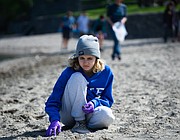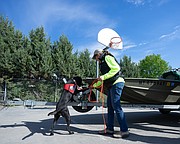Students search lake shoreline as part of science lesson
A zebra mussel is a small, roughly 1-inch wide creature with alternating dark brown stripes over the rest of its tan shell.
Or, put another way, they can be hard to spot on a beach, and even harder to deal with once they’ve settled in.
This was a lesson learned firsthand by Whitefish Middle School students, who recently capped off a week of aquatic invasive species lessons with a “Mussel Walk,” where they roamed City Beach looking for dead mussels and other creatures planted there by lake and biology experts.
The Mussel Walk program is a collaboration between the Flathead Lakers, the Flathead Lake Biological Station, Montana State Parks and the Confederated Salish and Kootenai Tribes. The Whitefish Lake Institute also helped out with the Whitefish event. Along with Whitefish, there was also Mussel Walks this spring at West Shore State Park, Salish Point, Wayfarers State Park and Yellow Bay on Flathead Lake this year.
Ian Whitworth, media and information specialist for the Flathead Lake Biological Station, said the event has grown from a single event on Flathead Lake to a series that spans multiple locations and schools. The thought behind the program was to begin preparing the next generation of lake users in the area, he said.
“It just started as a way to start engaging communities on the importance of monitoring boats, looking out for AIS and just trying to engage the younger generation so that as they grow older, they’ll have that in their minds and they’ll take responsibility,” he said.
“The intent was to get the students locally to step up and take care of their environment and to search for invasive mussels to prevent the spread of them,” Holly Church said.
Church is education coordinator at FLBS, and she and Hilary Devlin of the Flathead Lakers have been developing the Mussel Walk curriculum.
Along with the Mussel Walk along Whitefish Lake beaches, the students also took part in a week of AIS-based lessons and rotated through different learning stations.
The stations included lessons like properly washing and cleaning boating gear, how inspection stations evaluate boats and mussel-detecting dogs can find AIS hidden on an otherwise-clean boat.
The dead mussels planted on City Beach are meant to simulate one of Montana’s biggest threats to water sources, aquatic invasive species and zebra mussels specifically. While other states in the country are dealing with the aftermath of AIS in their waterways, Montana is still in the prevention stage.
Zebra mussels and other AIS in Whitefish Lake could have big economic and environmental effects, including plugging water intake pipes, clogging infrastructure and hurting the ecology and water quality of the lake.
Church said the final Mussel Walk along the beach seems to be a favorite for the students, who spend the last hour of the program with their heads craned down, scanning the sand for zebra mussels.
“I think ultimately this Mussel Walk ties it all together, and I would say they’ve been having a lot of fun doing the whole field trip and the activities we did at the school before we got here,” she said. “I enjoy this part, seeing them out and taking responsibility for what they’re doing and thinking about it.”
Whitworth said the program is working on packaging up the lessons taught throughout the week into a curriculum kit that can be sent out to schools in the future. That way, any school can go through the same learning material even if the program can’t make it to their classroom, he said.
Likewise, the lessons aren’t just for kids, he said.
“This is the same stuff we talk about when we talk to adult communities,” he said. “[These students] are going to be the future of this responsibility. They’re the up-and-comers, they’re going to be the community leaders so we don’t shy away from putting the responsibility on them. This is their place, this is their home, and they have just as much of a say in protecting it as anybody else.”










